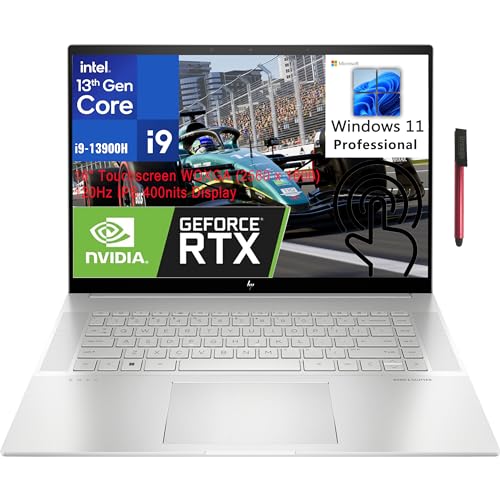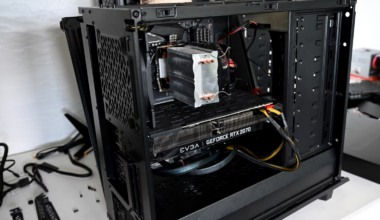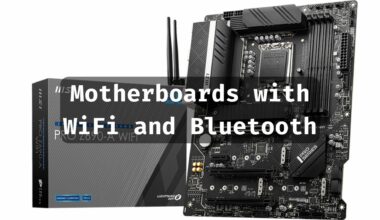An external GPU (or eGPU) is the most convenient and cost-effective way to harness the power of a desktop-class GPU on a laptop. Where RAM and SSD storage are commonly upgradeable on most laptops, dedicated GPUs don’t offer that luxury. However, eGPUs enable you to circumvent this problem easily while giving your computer tremendous processing power to handle the sophisticated graphics of modern games.
A Thunderbolt eGPU enclosure has a PCIe slot and uses PCIe tunneling and your computer’s Thunderbolt port, enabling you to connect a desktop-class GPU. Choosing the suitable device is easy as long as your eGPU enclosure has the right amount of power and a compatible PCIe slot.
Unfortunately, finding laptops that allow you to use eGPUs is challenging because the decision rests on several factors, which we’ll discuss in our next section. At the outset, choosing a laptop that facilitates using eGPUs is like selecting any computer.
You are all set with a high-performance processor, fast RAM, ample storage, and a versatile selection of ports. But using an eGPU requires more than just these basic features.
Essential Features Of A Laptop For eGPUs

Few laptops enable you to use an eGPU enclosure. A high-speed port is vital, but you’ll need a few more features to enjoy an immersive gaming experience, the kind you get in fully-loaded desktop setups.
You can choose between laptops that offer USB4 and Thunderbolt ports. However, we recommend selecting a Thunderbolt Laptop since USB4 does not guarantee a high data transfer speed.
Thunderbolt ports that support 40Gbps data speed and PCIe tunneling are perfect for connecting an eGPU. Thunderbolt 4 supports these features compulsorily and is preferable over using older Thunderbolt versions that don’t. Modern high-end GPUs like the NVIDIA GeForce RTX 4080
Besides using a Thunderbolt 4, you must ensure your computer has a display with high-refresh rates. You’ll be fine if you are using an external monitor. If not, having a sub-par screen won’t do justice to your gaming setup if the display has a low refresh rate. Gaming visuals will be choppy, and you’ll have to deal with distortions like image tear and ghosting, which are undesirable, considering you’ll spend a few thousand dollars to build your gaming setup.
Interestingly, you’ll only find high refresh rates on gaming laptops with a dedicated GPU, negating the need for an eGPU altogether. But remember, your eGPU enclosures facilitate easy upgrades and are a great way to future-proof your gaming setup.
While you can also use eGPUs for content creation workflows, most people reading this guide will want one for gaming. Thus, it is essential to ensure that your laptop has a formidable thermal infrastructure that facilitates key components performing at their peak levels.
Table of Contents
- Essential Features Of A Laptop For eGPUs
- Comparison of the Best Laptops For eGPU
- 1. Razer Blade 15 – Our Pick
- 2. ASUS ROG Strix G16 – Excellent Thermal Design
- 3. No products found. – High-Resolution High Refresh Rate
- 4. HP ENVY 16-inch Touchscreen – Content Creation and Light Gaming
- 5. Acer Predator Helios 16 – Value For Money
- 6. GIGABYTE AORUS 17 – 17-Inch Display
- 7. MSI Raider GE68Hx – 13th-Generation Intel Core i9 Processor
- 8. ASUS TUF Dash 15 – Budget Pick
- Best Laptops For eGPU – Frequently Asked Questions (FAQs)
Comparison of the Best Laptops For eGPU
| Image | Product | Details | Check Price |
|---|---|---|---|
 | Razer Blade 15 | Display: 15.6-inch IPS Refresh Rate: 240Hz Resolution: 2560x1440 CPU: Intel Core i7-13800H GPU: NVIDIA GeForce RTX 4060 RAM: 16GB DDR5 Storage: 1TB SSD Ports: 2x Thunderbolt 4 3x USB-A 3.2 Gen 2 1x HDMI v.2.1 1x 3.5mm Combo Jack 1x Media Card Reader Connectivity: Wi-Fi 6E and Bluetooth 5.2 Date Released: Feb-2023 | Buy on Amazon |
 | ASUS ROG Strix G16 | Display: 16-inch IPS Refresh Rate: 165Hz Resolution: 1920x1200 CPU: Intel Core i7-13650HX GPU: NVIDIA GeForce RTX 4060 RAM: 32GB DDR5 Storage: 2TB SSD Ports: 1x Thunderbolt 4 1x USB-C 3.2 Gen 2 2x USB-A 3.2 Gen 2 1x HDMI v.2.1 1x 3.5mm Combo Jack 1x RJ-45 Connectivity: Wi-Fi 6E and Bluetooth 5.2 Date Released: Jul-2023 | Buy on Amazon |
| No products found. | Display: 16.1-inch IPS Refresh Rate: 240Hz Resolution: 2560x1440 CPU: Intel Core i7-13700HX GPU: NVIDIA GeForce RTX 4060 RAM: 32GB DDR5 Storage: 1TB SSD Ports: 2x Thunderbolt 4 2x USB-A 3.1 1x HDMI v.2.1 1x 3.5mm Combo Jack Connectivity: Wi-Fi 6E and Bluetooth 5.3 Date Released: Jun-2023 | No products found. | |
 | HP ENVY 16-inch Touchscreen | Display: 16-inch IPS Refresh Rate: 120Hz Resolution: 2560x1600 CPU: Intel Core i9-13900H GPU: NVIDIA GeForce RTX 4060 RAM: 64GB DDR5 Storage: 4TB SSD Ports: 2x Thunderbolt 4 2x USB-A 3.2 Gen 2 1x HDMI v.2.1 1x 3.5mm Combo Jack Connectivity: Wi-Fi 6E and Bluetooth 5.3 Date Released: Jul-2023 | Buy on Amazon |
 | Acer Predator Helios 16 | Display: 16-inch IPS Refresh Rate: 165Hz Resolution: 2560x1600 CPU: Intel Core i7-13700HX GPU: NVIDIA GeForce RTX 4060 RAM: 16GB DDR5 Storage: 1TB SSD Ports: 2x Thunderbolt 4 2x USB-A 3.2 Gen 2 1x USB-A 3.2 Gen 1 1x HDMI v.2.1 1x RJ-45 1x 3.5mm Combo Jack Connectivity: Wi-Fi 6E and Bluetooth 5.1 Date Released: Jul-2023 | Buy on Amazon |
 | GIGABYTE AORUS 17 | Display: 17.3-inch IPS Refresh Rate: 240Hz Resolution: 2560x1440 CPU: Intel Core i7-13700H GPU: NVIDIA GeForce RTX 4070 RAM: 16GB DDR5 Storage: 1TB SSD Ports: 1x Thunderbolt 4 1x Mini DisplayPort 3x USB-A 3.2 Gen 1 1x HDMI v.2.1 1x RJ-45 1x Media Card Reader 1x 3.5mm Combo Jack Connectivity: Wi-Fi 6E and Bluetooth 5.2 Date Released: Feb-2023 | Buy on Amazon |
 | MSI Raider GE68Hx | Display: 16-inch IPS Refresh Rate: 240Hz Resolution: 2560x1600 CPU: Intel Core i9-13950HX GPU: NVIDIA GeForce RTX 4060 RAM: 16GB DDR5 Storage: 1TB SSD Ports: 1x Thunderbolt 4 1x USB-C 3.2 Gen 2 2x USB-A 3.2 Gen 2 1x HDMI v.2.1 1x RJ-45 1x Media Card Reader 1x 3.5mm Combo Jack Connectivity: Wi-Fi 6E and Bluetooth 5.2 Date Released: Jan-2023 | Buy on Amazon |
 | ASUS TUF Dash 15 | Display: 15.6-inch IPS Refresh Rate: 144Hz Resolution: 1920x1080 CPU: Intel Core i7-12650H GPU: NVIDIA GeForce RTX 3060 RAM: 16GB DDR5 Storage: 512GB SSD Ports: 1x Thunderbolt 4 2x USB-C 3.2 Gen 2 2x USB-A 3.2 Gen 1 1x HDMI v.2.0 1x RJ-45 1x Media Card Reader 1x 3.5mm Combo Jack Connectivity: Wi-Fi 6 and Bluetooth 5.2 Date Released: Feb-2022 | Buy on Amazon |
1. Razer Blade 15 – Our Pick
Razer is one of the leading manufacturers of gaming laptops and the go-to brand for many avid gamers because their laptops pack in top-of-the-line specifications that ensure superior performance. The Blade 15 is no exception and perfectly balances high and mid-range specifications.
Razer offers a 15.6-inch IPS panel display with a 1440p QHD resolution, perfect for all the latest AAA gaming titles. However, the express refresh rate of 240Hz and incredibly low response times of 2.5ms promise minimal image distortion during your high-speed, action-packed gaming marathons. The display also supports G-Sync, improving overall gaming performance by directly allowing the GPU to demand high refresh rates from the display panel.
The laptop features Intel’s 13th-generations Core i7-13800H processor, which has 14 cores, 24MB Cache, and clock speed up to 5.2GHz. This model has 1TB SSD storage and a modest 16GB RAM, allowing you to start small and expand when needed. You can upgrade up to 64GB RAM and 4TB storage to extract more from this gaming monster.
The Blade 15 is a proper gaming laptop complete with an efficient thermal infrastructure and a dedicated GPU. The NVIDIA GeForce RTX 4060 GPU ensures you get an immersive gaming experience. But if you want to go high-end with the RTX 4090, you can use one of the laptop’s two Thunderbolt 4 ports for a quick upgrade using an eGPU enclosure.
- The high-resolution screen and 240Hz refresh rate ensure excellent gaming graphics.
- Wi-Fi 6E and Bluetooth 5.2 provide high-speed wireless access.
- Two Thunderbolt 4 ports allow you to connect multiple Thunderbolt devices.
- Easily upgradable RAM and storage.
- The 7.1 surround sound provides an immersive audio experience.
- Expensive
- No Ethernet port, so you must use a Thunderbolt dock.
2. ASUS ROG Strix G16 – Excellent Thermal Design
The Razer Blade 15 is good, but if you want a laptop that’s as punchy without burdening your pocket, the Asus ROG Strix G16 is for you. It offers excellent mid-range specifications, perfect for an immersive gaming experience, and the significant price difference will save you a ton of money without sacrificing performance.
Admittedly, you get more bang for your buck with its 32GB DDR5 RAM compared to Razer’s 16GB RAM. You also get double the storage, allowing you to create your media library without worrying about running out of space. The G16 has Intel’s 13th-generation Core i7-13650HX processor, with 14 cores, 20 threads, and a clock speed of up to 4.90GHz.
It uses the same GPU as the Razer, but you’ll have to settle for a lesser screen as the G16’s display offers a resolution of 1920×1200. The screen supports leading VRR (Variable Refresh Rate) technologies, including G-Sync, Adaptive Sync, and FreeSync. Still, with a maximum refresh rate of 165Hz, the G16 ‘s panel seems ordinary compared to the Blade 15.
Nevertheless, the G16 is an excellent gaming machine with an effective thermal design that’ll keep you gaming for long hours. Asus combines a triple-fan design with full-size heatsinks, ensuring adequate ventilation for all critical components. It also features Thermal Grizzly’s Conductonaut Extreme, an ultra-high-performance liquid metal compound that carries heat away from the CPU and other vital parts.
- The comprehensive thermal design ensures sustained performance.
- Wi-Fi 6E and Bluetooth 5.2 provide high-speed wireless access.
- The specifications are geared for top-notch gaming performance.
- The HDMI 2.1 port enables you to connect high-resolution external monitors.
- Excellent value compared to the competition.
- Only one Thunderbolt 4 port.
- The 165Hz refresh rate is low compared to competitors.
3. No products found. – High-Resolution High Refresh Rate
No products found.
An immersive gaming experience is all about displaying lifelike images that are as close to reality as possible. To achieve this, it would be best to have a large display with a high resolution and an equally good refresh rate. High-resolution screens ensure near-perfect image clarity and a high refresh rate prevents image tears in fast-paced gaming scenes.
The HP Omen is a 16.1-inch IPS panel display with a 2560x1440p resolution and 240Hz refresh rate, all essential features that make gaming pleasurable on this laptop. It covers 100% of the sRGB color gamut and has a response time of just 3ms which prevents ghosting and enhances the overall gaming experience. So when you hook up an eGPU, the Omen screen will surely delight you with its near-perfect image quality.
But besides a great screen, HP also packs the Omen with tremendous processing power, which includes Intel’s 13th-generation Core i7-13700HX processor, 32GB DDR5 RAM, and 1TB NVMe SSD storage. You also get a mid-range NVIDIA GeForce RTX 4060 with 8GB GDDR6 VRAM. So while your short-term gaming needs are well catered for, you can use an eGPU for upgrades.
That shouldn’t be a problem, considering you have two Thunderbolt 4 ports at your disposal, one for the eGPU and the other for connecting your Thunderbolt dock.
- Minimal gaming aesthetics on the outer shell give the HP Omen an understated appeal.
- Two Thunderbolt 4 ports allow you to connect multiple Thunderbolt devices.
- The high-resolution and high refresh rate provide an immersive gaming experience.
- Wi-Fi 6E and Bluetooth 5.2 provide high-speed wireless access.
- Excellent sound quality with Bang and Olufsen audio.
- The screen has low brightness with just 300nits.
- The build quality could be better, especially considering the price.
4. HP ENVY 16-inch Touchscreen – Content Creation and Light Gaming
Besides gaming, pairing a high-end laptop with an eGPU is a viable solution to content creation workflows. A high-performance CPU, paired with top-of-the-line RAM and colossal storage, are some of the features the HP Envy has to offer.
The laptop uses Intel’s 13th-generation Core i9-13900H processor with six performance cores, eight efficiency cores, 20 threads, and up to 5.4GHz clock speed, offering top-notch performance when paired with 64GB DDR5 RAM. It’s perfect for rending high-resolution videos and other related tasks. Moreover, the Envy’s 4TB SSD storage is large enough to store huge files for editing at your convenience.
The HP Envy also features a large 16-inch touchscreen with 2560x1600p resolution and 120Hz refresh rate. Images look crisp on this IPS panel with 400nits brightness and 100% sRGB color gamut. Agreed, it’s not the ideal screen for high-performance gaming, but the computer is well equipped to handle light gaming when you want a break from your graphics editing work.
The port selection is standard. You’ll find a couple of USB-A ports, an HDMI v.2.1, and a media card reader on the left and right flanks. Thankfully, HP very thoughtfully includes two Thunderbolt 4 for your convenience for connecting compatible devices.
- Top-of-the-line specifications give it tremendous processing power.
- Excellent screen with bright and lifelike color representations.
- Two Thunderbolt 4 ports allow you to connect multiple Thunderbolt devices.
- Excellent sound quality with Bang and Olufsen audio.
- Wi-Fi 6E and Bluetooth 5.3 provide high-speed wireless access.
- Expensive
- The laptop is heavy, making it challenging to carry while traveling.
5. Acer Predator Helios 16 – Value For Money
The Predator Helios 16 is a well-rounded gaming laptop you can use with an eGPU. It has two Thunderbolt 4 ports, which means you can use one for the eGPU and the other for daisy chaining additional Thunderbolt 4 devices. Moreover, its mid-to-high-range specifications are suitable for any gaming title, and Acer pairs these specifications with a brilliant screen, ensuring an immersive gaming experience.
The laptop has an Intel Core i7-13700HX processor (16-cores, 30MB Cache, and up to 5GHz clock speed). This is a value pick, so you won’t get a colossal amount of RAM. Nevertheless, the model has 16GB DDR5 RAM, and you can upgrade it to 32GB using the two slots that Acer provides. The Helios 16 comes with 1TB PCIe Gen 4 NVMe SSD storage that facilitates superfast memory operations, essential to high-performance gaming.
A gaming computer is incomplete without a good display. And for this, the Helios 16 has a 16-inch IPS panel display that ensures excellent image clarity with a 2560x1600p resolution. You’ll enjoy playing action-packed games as the screen has a 165Hz refresh rate and 3ms response time that prevents image distortions. More importantly, it supports G-Sync, NVIDIA VRR technology that will help you enhance gaming visuals when you hook up your eGPU.
- The specification is suitable for high-performance gaming.
- Excellent value for money.
- The brilliant screen makes gaming an enjoyable experience.
- Wi-Fi 6E and Bluetooth 5.1 provide high-speed wireless access.
- RGB backlit keyboard and peripheral lighting provide pleasing gaming aesthetics.
- The fans are loud at peak performance levels.
- Some reports of overheating.
6. GIGABYTE AORUS 17 – 17-Inch Display
The Gigabyte Aorus 17 is perfect for gamers wanting to avoid using an external display for their gaming stations. But a 17-inch screen on a laptop has several implications in terms of the size of the computer as well.
But Gigabyte navigates these implications creatively by packing the Aorus 17 with helpful gaming features. These include an Intel Core i7-13700H processor with a clock speed of up to 5GHz and 14 cores (6-P and 8-E). You get 16GB DDR4 RAM and two slots which allow you to scale this up to 64GB. And the laptop also has 1TB SSD storage, which is upgradable using the two M.2 SSD slots.
The 17.3-inch screen of the Aorus 17 has thin bezels, giving you a higher screen-to-body ratio, perfect for immersive gaming and professional workflows. Images are crisp thanks to the 2560x1440p resolution, which Gigabyte configures in a 16:9 aspect ratio and delivers a refresh rate of 240Hz.
Notably, the screen offers superior color accuracy while also ensuring you don’t feel eye strain. It has a high color gamut that covers 100% of the sRGB color space and comes with TUV Rheinland certification for low blue-light emissions.
- The 17-inch screen eliminates the need for an external monitor.
- The MUX switch allows you to tweak the screen’s performance.
- Wi-Fi 6E and Bluetooth 5.2 provide high-speed wireless access.
- The TUV Rheinland-certified screen ensures minimal eye strain.
- Plenty of ports to connect I/O devices.
- Only one Thunderbolt 4 port.
- Pricey
7. MSI Raider GE68Hx – 13th-Generation Intel Core i9 Processor
Gaming is a CPU and GPU-intensive task, and having the right combination is essential for uninterrupted gameplay. The MSI Raider GE68Hx has an Intel Core i9-13950HX processor with 24 cores (8-P and 16-E), a 36MB Cache, and up to 5.50GHz clock speed (in turbo mode). In comparison, other specifications seem modest, with 16GB DDR5 RAM and 1TB SSD storage. But they are upgradeable, and you can expand these when needed.
The GE68Hx has a 16-inch QHD+ display with a resolution of 2560x1600p in a 16:10 aspect ratio and a refresh rate of 165Hz. MSI pairs this display with the NVIDIA GeForce RTX 4060 GPU with all Ray Tracing and AI-based audio-video enhancers that provide exceptional gaming graphics. Of course, you can do better, and the Raider has a Thunderbolt 4 port that enables the use of an eGPU.
The laptop’s thermal architecture is underpowered and includes two high-speed fans and six heat pipes that carry the heat away from critical components like the CPU and GPU. While it’ll prevent overheating, the fans make much noise when you push processors to perform at peak levels.
The MSI Raider GE68Hx has plenty of ports around the left, right, and back panels, including an HDMI v.2.1 port for 8K external displays. Alternatively, you can use a Thunderbolt 4 port on the machine for the same purpose, but that would mean choosing between an eGPU and an external display.
- The 13th-generation Intel Core i9 processor provides tremendous processing power.
- The 16:10 aspect ratio is ideal for workflows involving spreadsheets or writing code.
- Multiple video ports facilitate a triple monitor display.
- Wi-Fi 6E and Bluetooth 5.2 provide high-speed wireless access.
- The RGB lighting enhances the gaming experience.
- Only one Thunderbolt 4 port.
- The fans get noisy when the CPU and GPU perform at peak levels.
8. ASUS TUF Dash 15 – Budget Pick
The Asus TUG Dash 15 is suitable for gamers on a budget. In technology, you often get the most valuable deals by purchasing products of one previous generation. The TUF Dash 15 is an excellent example of the same.
Instead of the current generation of Intel processors (13th-generation), this laptop uses Intel’s Core i7-12650H processor (10-cores, 24MB Cache, and up to 4.7GHz clock speed) belonging to the 12th-generation of Intel’s line-up. You get 16GB of the current DDR5 RAM and a modest 512GB SSD, which are small but effective ways to cut costs without sacrificing much performance.
What’s more, instead of the current 4000 series NVIDIA GPUs, Asus offers an older NVIDIA GeForce RTX 3060 GPU with 6GB GDDR6 VRAM. So, while this goes a long way in reducing costs, it makes for the most convincing case for using a modern eGPU. Moreover, with two GPUs at your disposal, you can pick which GPU better serves your gaming title.
The TUF Dash 15 truly belongs to an older generation, and this is further evident when you examine the screen’s specifications. Compared to modern gaming laptops, the Dash 15 has a conventional FullHD 1080p screen with a 144Hz refresh rate on its 15.6-inch IPS panel display. While the gaming visuals are not bad, they are no match for the latest display technologies that offer higher resolutions and refresh rates. But then, this is our budget pick, and these limitations have an easy workaround if you use an eGPU and external monitor.
- Price
- The 12th-generation Intel processor and DDR5 RAM provide gaming performance.
- The 144Hz refresh rate helps prevent image distortion while gaming.
- Durable body with MIL-STD-810H military-grade toughness.
- The older generation specifications will limit gaming your gaming experience.
- You only get Wi-Fi 6.
Best Laptops For eGPU – Frequently Asked Questions (FAQs)
Can I Use An eGPU With An AMD Laptop?
An eGPU requires fast data transfers that are mainly possible using Thunderbolt ports. But only a few laptop manufacturers offer Thunderbolt ports on the AMD platform. However, using a USB4 port is an alternate solution, and several manufacturers offer USB4 AMD laptops. But since USB4 does not guarantee Thunderbolt’s 40Gbps data transfer speed and PCIe Tunnelling remains optional on USB4, you must ensure that the USB4 port supports these features.
What Is PCIe Tunnelling? And Why Is It Necessary For eGPUs?
Add-in cards, such as GPUs, require PCIe slots to communicate with the motherboard. This is fine on desktop motherboards, as all motherboards offer PCIe slots. The concept of add-in cards does not exist (anymore) in modern laptops, and you must rely on I/O ports such as those of USB and Thunderbolt standards.
In its simplest form, PCIe Tunnelling allows these ports to send signals to the motherboard, even if you connect them via an external PCIe device such as an eGPU enclosure.
Can I Use My Laptop’s GPU Even If I Have An eGPU?
While you can connect an eGPU to a laptop with a dedicated GPU, you must select which one the system will use. Your computer can only use one GPU at a time, and in most cases, switching between GPUs is a cumbersome task. Hence, it’s advisable to select the higher card and go with that.
Does Using an eGPU Compromise Its Performance?
Some studies show that GPUs perform 10 to 15 percent lower when used externally. But one way to negate that is by using an eGPU with a higher performance rating to offset this difference.
![Best 3:2 Aspect Ratio Laptops [2023] 39 Laptops 3by2](https://bytexd.com/wp-content/uploads/2022/04/Laptops-3by2-380x220.jpg)

![Best DD-WRT Routers [2023] 41 best routers](https://bytexd.com/wp-content/uploads/2022/11/best-routers-380x220.jpg)

